An analysis of Digital PR Campaigns for financial service brands
You’ll probably know that the main purpose of a Digital PR campaign is to build you links. So you might ask, if it does that, why do I need to worry about anything else? If you’ve ever found yourself in a position where you’ve run a campaign, built links, and then seen little to no beneficial impact to your website, you’ve just answered the question.
When done right, Digital PR campaigns can substantially increase your website’s performance and ability to rank for key terms. But this can be hard to get right, particularly in more niche industries.
With the financial services industry being one on the trickier side, we’ve analysed Digital PR campaigns from the past two years to highlight where it can truly provide value for brands when done right, and where it can hinder when done badly.
But first, let’s recap on what makes a good link
I’ll only cover this briefly, as it’s a common topic of discussion. Links are not all created equal, a good link for one brand could be a useless link for another. When it comes to assessing a link, there are three main factors to consider:
- Quality – is the link from an authoritative, trustworthy site? Our preferred metric for assessing this is Majestic’s Trust Flow.
- Relevance – is the linking website and context of the link a natural, relevant fit for the brand it’s linking to and its product offering? A fantasy football site wouldn’t make much sense linking to a company that offers pensions, for example.
- Diversity – not all links to a website should be from the same website, or type of website. For example, having purely links from directories will provide diminishing returns over time.
Link metrics are one of the ways that we’ve analysed the 50 campaigns, so it’s important this is covered. Now onto the findings…starting with campaign format.
Lists and mixed-format campaigns secured the most links, but interactives, indexes and visual campaigns secure higher quality links
You’ll often hear that different campaign formats can vary in their ability to secure links in the first place. A while back, infographics were the go-to, but times have moved on and so have the formats being explored for Digital PR.
This in part has come from journalists changing their policies and declining infographics. But also due to an understanding that Digital PR can no longer act in silo, but needs to be part of wider SEO and content strategy… Tools, keywords and the onward journey come into play and a static, pdf or jpeg infographic doesn’t really allow for this as they cannot be crawled.
There’s quite a significant difference in the number and quality of links being secured by the different formats. List and mixed format campaigns (ranking & report) secure the highest number of links, while visual campaigns (ones that solely rely on visual assets as the entire concept) secure the highest quality links, followed by interactives and indexes. At the opposite end of scale, case studies secure the lowest number of links but one of the med-higher average Trust Flow of links at 16.
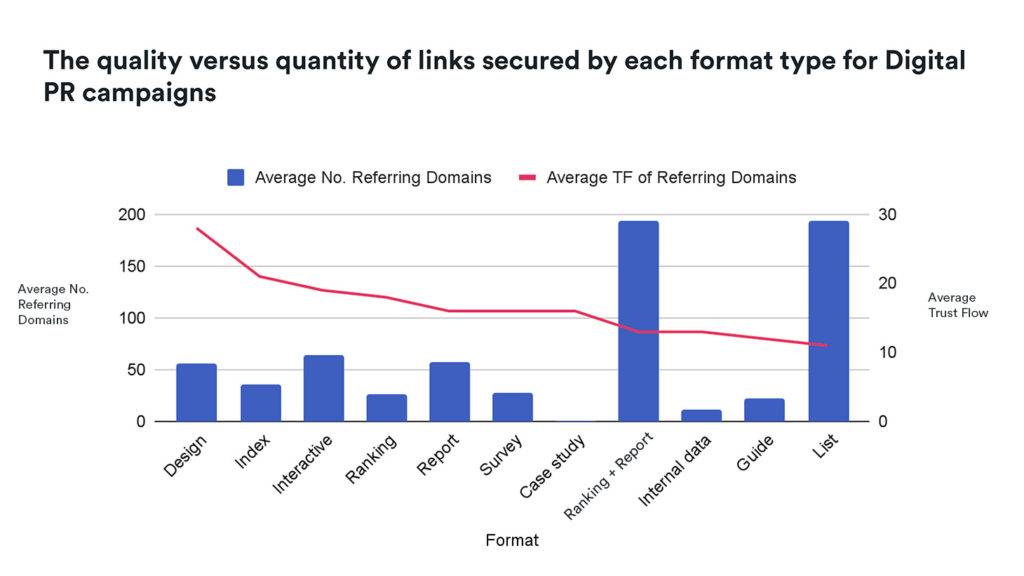
Source: majestic.com.
As mentioned earlier though, quality and quantity aren’t the only factors to take into account when scoring backlinks secured by campaigns. You’ll also want to look into followed vs no-follow links and relevancy of the link and content in which it sits…
Mixed format, report and index campaigns drive the most followed links while guides and lists secure the most no-follow links
Not too long ago, Google announced that no-follow links do pass some signals, or ‘hints’, from one website to another – causing quite a stir for us SEO folk!
However, still to this day, a lot of companies will only recognise ‘followed links’ (I could write a whole other piece on this, but we’ll move on) so it’s important to analyse as part of our report.
It’s interesting to see that guides and lists have a lower follow to no-follow link ratio. This may be due to a number of scraper sites syndicating the content, so considering this, it might not be a bad thing that they include no-follow links as it’s less likely you’ll want to be associated with these kind of poor quality sites.
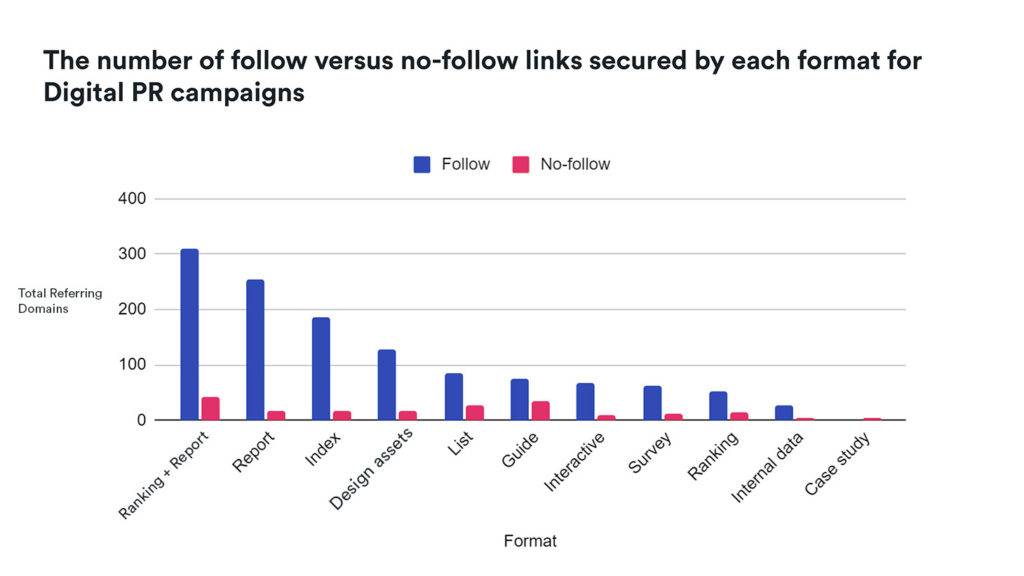
Source: majestic.com.
Ranking and indexes cover topics with the least relevancy to a brand’s services or products, despite driving high link volumes
Remember how I defined the relevancy of a link earlier on in this report? That’s exactly what we’re looking at here, how relevant a campaign and the links it’s secured are to your brand’s product or service it’s operating.
Up until this point, it may have looked like particular formats (visuals, rankings, index etc.) were doing ‘okay’ in terms of performance. But when it comes to one of our three main factors to consider when assessing a link, relevancy, it’s the campaign formats that use internal data, case studies and reports that take top spot.
Not really surprising when you think about it…but it’s definitely food for thought considering some of the Digital PR campaigns we still see launched today.
Visual campaigns, indexes and rankings are the campaign formats that tend to have the least relevancy. These formats, as our data shows, can be great for securing a higher quantity of links due to having a broad reach. But it seems too often, going for link numbers has a detrimental effect on quality and relevancy of links secured.
In part two of the report I’ll be digging deeper into how to strike a balance between all three factors when it comes to launching campaigns.
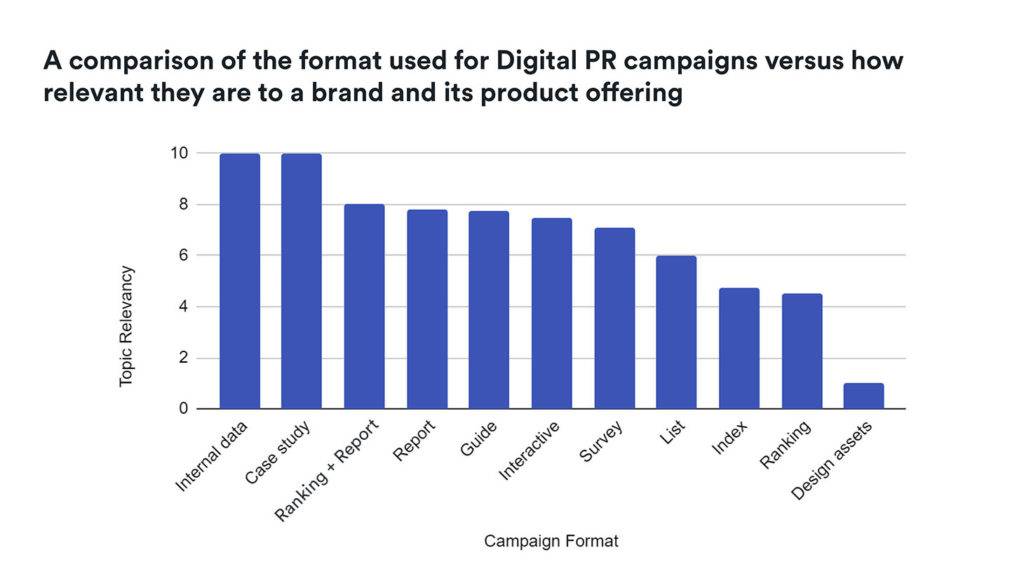
Source: majestic.com
Companies offering trading create the most relevant Digital PR campaigns
I’ve mentioned that Digital PR for financial service brands is tricky, and this is for a number of reasons. One being that finance sites are notorious for no linking policies, but even before that when it comes to creating campaigns, the industry often have heavy compliance (internally and externally) to consider.
One area in particular that has many rules around the kind of content that you can publish is trading, which may be the reason that most of the content brands create in this space is more relevant. Meanwhile, brands in price and insurance comparison have a bit more ‘freedom’ to talk about a broader range of topics.
That sounds like it might be a good thing, but moving too far away from your brand’s offering obviously impacts relevancy, resulting in a knock on effect to the types of links campaigns secure. A relevant link can aid in driving relevant traffic to your site so that users that end up on your campaign page are more inclined to continue browsing to deeper sections of your site.
In the chart below, instead of looking at format, we’ve grouped campaigns by the service or product offering of a company, such as trading, bank or price comparison site to uncover what impact this has on a campaign’s relevancy and the links it secures.
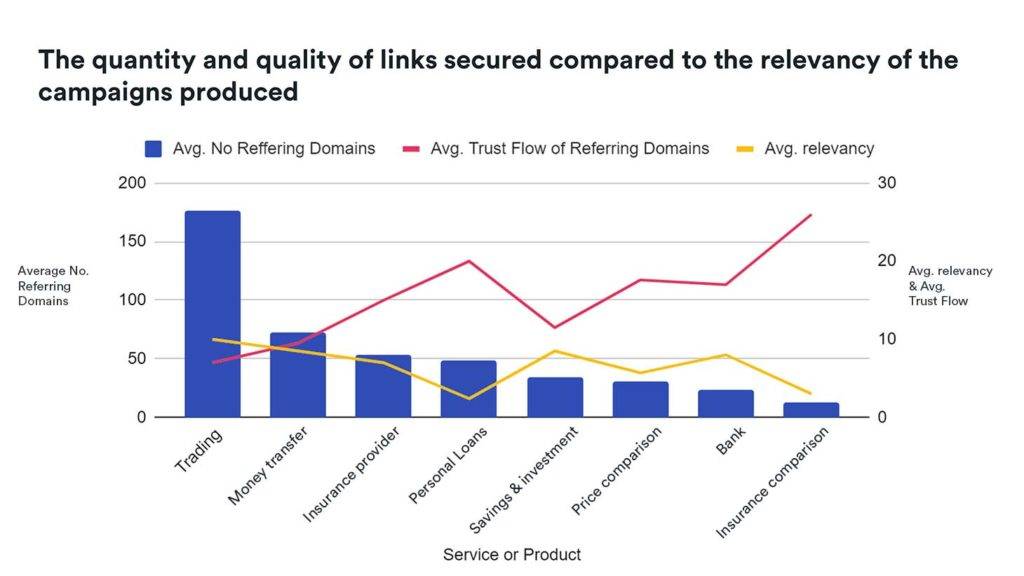
Source: majestic.com
The relevance of a campaign doesn’t impact its ability to secure followed links
From this example, we can see very little correlation between a campaign’s ability to secure followed links and how relevant it is. I am a little surprised by this as generally you’d think relevant websites would be more likely to include a followed link (or vote) to a piece of content that’s highly relevant and valuable for their users.
But clearly, that notion isn’t true!
I couldn’t make that statement though without the one anomaly that is relevant and followed links to campaigns produced by trading firms – which score high on both. This may be due to rules around the kind of content trading firms can produce, and the formats used for campaigns.
Even though these links might not be followed links, as the campaigns are relevant, any traffic coming through the link should be of value as the traffic itself will likely be relevant too.
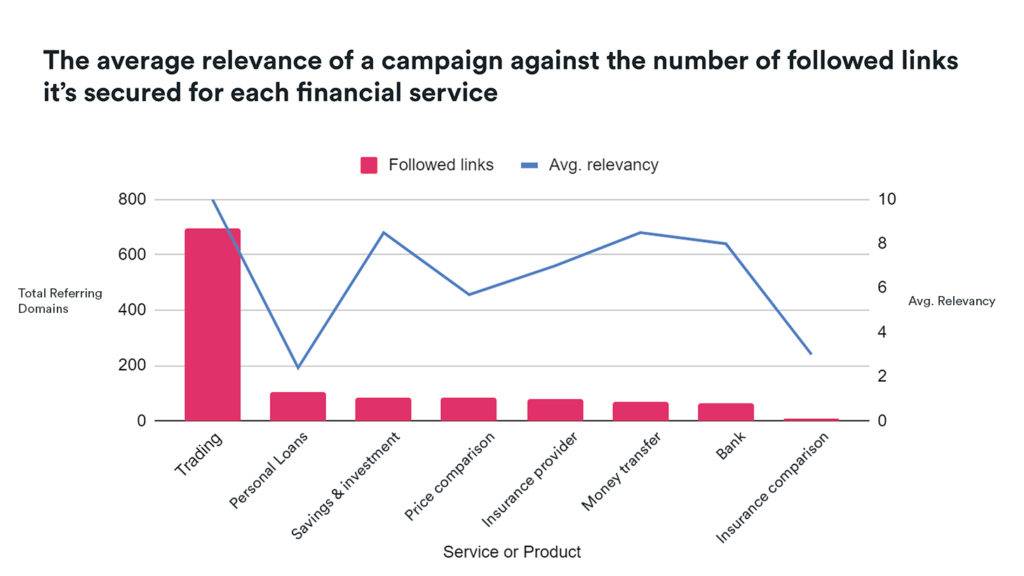
An example of Topical Trust Flow for a relevant versus non-relevant campaign
Just briefly, Topical Trust Flow (TTF) is how authoritative and trustworthy a domain or URL is within its niche and what topic the content is about. Obviously, you’ll want to be authoritative and trustworthy within your own niche, yes? This is assessed by the types of links you secure back to your sites. This is why it’s so important to build relevant campaigns.
We’ve looked at the Topical Trust Flow for two very different campaigns to showcase the impact relevancy and links can have. Firstly, below is an example from NetCredit that’s a creative idea on reconstructing six ruined castles. This picked up some great quality links on the likes of CNN, but the majority were on design-related sites such as Daily Art Magazine. This has resulted in the page having a TTF in arts and illustrations, which of course is quite irrelevant to the personal loans that NetCredit offers.
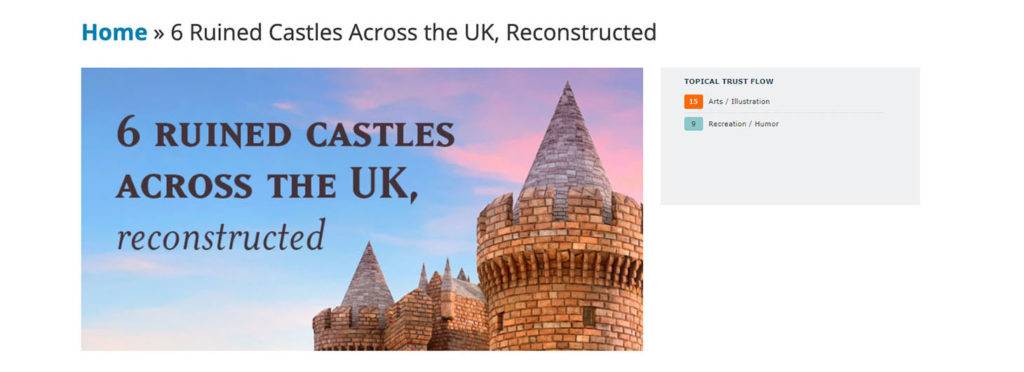
Source: https://www.netcredit.com/blog/6-ruined-castles-across-uk-reconstructed/
The second campaign is a guide on gifting money to children by Raisin, a company offering savings and investments. This has secured links on government, finance and family/parenting sites all relevant to financial services resulting in the page having a highly relevant TTF in business, financial services and internet.
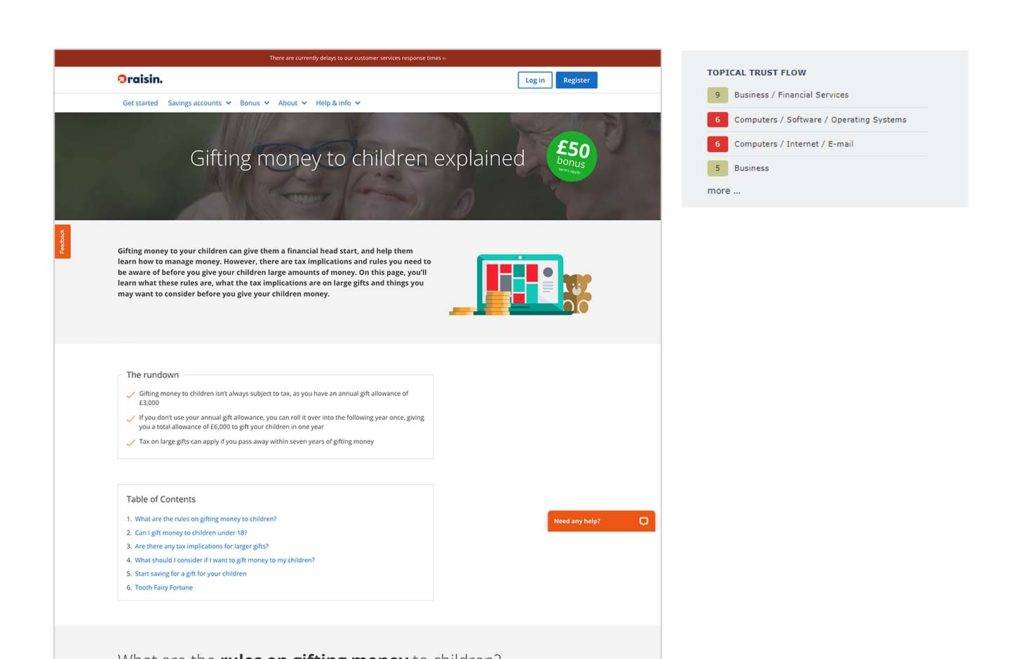
Source: https://www.raisin.co.uk/taxes/gifting-money-to-children/
Not only will these relevant campaigns get the right links, they’ll also capture the right audience meaning that anyone that ends up on the site are much more likely to move to deeper sections of the site, and potentially even buy!
This is something I’ll discuss more in part two.
Personal loan, trading and price comparison sites comply the most with EAT and YMYL guidelines
Financial services are classed as YMYL websites due to the information, products and services that they offer. If you’re not familiar with EAT and YMYL, my colleague Alex wrote a piece on how brands in this space can improve EAT which is worth reading up on.
One thing I’ll say here is that considerations around EAT and YMYL should be made when creating campaigns from ideation through to production and outreach.
However, our data and research shows that perhaps this is still an after thought for many Digital PR campaigns. I’d be very keen to discuss this with anyone that’s passionate about EAT and YMYL so do leave your thoughts in the comments.
Personal loans as a product have come under a lot of fire, not just in recent years, but historically for immoral practices, leaving a lot of people lacking trust in them. It’s interesting to see here that campaigns in this space are more likely to consider such factors as including authors, or clear methodologies etc. – perhaps this is them employing steps to combat the aforementioned issue?
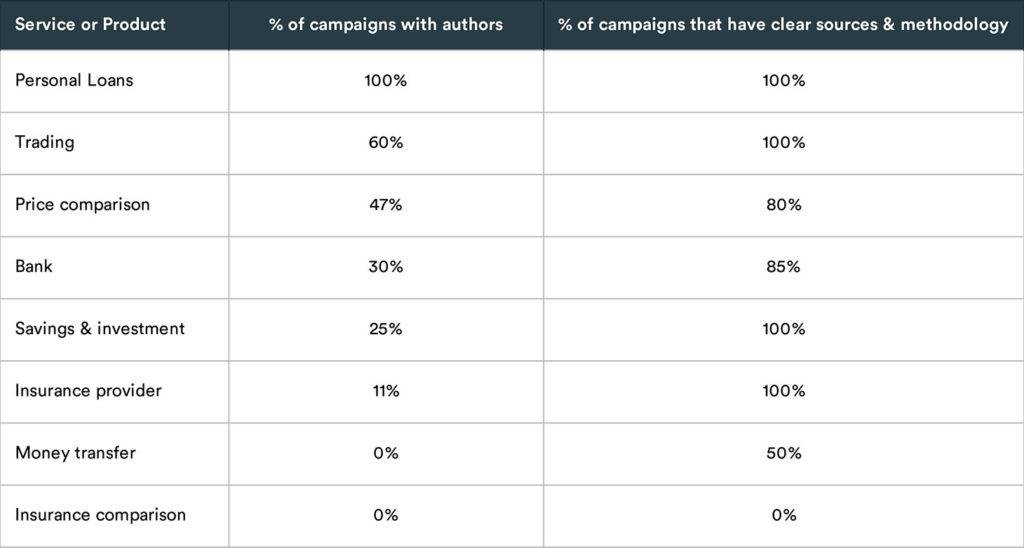
…
It’s worth saying that there’s obviously no one-size-fits-all approach. Depending on your brand and niche within finance you’re going to have to do something different in order to stand out, which is why we see so many different types of campaigns.
That being said, these findings show that financial service brands should be doing more to uphold the standards of their content when it comes to Digital PR campaigns. Through doing so, there are many things they can seek to gain, so stay tuned for part and more insights on this specifically…
Methodology
To uncover our findings, we selected 50 campaigns that cover a variety of brands and offerings in the financial service industry over the past two years. These were chosen to ensure a good mix of formats, topics, etc. to form a fair analysis.
We then ran backlink reports using Ahrefs and SEO Majestic to uncover how many and what types of links each of the pieces had secured against other factors including format, topic and relevancy.
The relevancy score is a scale of 0-10 (10 is best) and was attributed based on how close a campaign topic was to a brand’s product offering or services, and therefore how relevant it would be to a brand’s target audience.
This data was then analysed and compared to reveal the findings of the report.
Article for further reading from our blog:
https://builtvisible.com/the-crucial-role-clients-play-in-digital-pr-and-link-building/
https://builtvisible.com/seo-for-financial-services-off-page-seo/
https://builtvisible.com/are-you-paying-for-links-with-your-principles/
